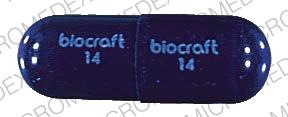Oxacillin Disease Interactions
There are 4 disease interactions with oxacillin.
Antibiotics (applies to oxacillin) colitis
Major Potential Hazard, Moderate plausibility. Applicable conditions: Colitis/Enteritis (Noninfectious)
Clostridioides difficile-associated diarrhea (CDAD), formerly pseudomembranous colitis, has been reported with almost all antibacterial drugs and may range from mild diarrhea to fatal colitis. The most common culprits include clindamycin and lincomycin. Antibacterial therapy alters the normal flora of the colon, leading to overgrowth of C difficile, whose toxins A and B contribute to CDAD development. Morbidity and mortality are increased with hypertoxin-producing strains of C difficile; these infections can be resistant to antimicrobial therapy and may require colectomy. CDAD must be considered in all patients who present with diarrhea after antibacterial use. Since CDAD has been reported to occur more than 2 months after antibacterial use, careful medical history is necessary. Therapy with broad-spectrum antibacterials and other agents with significant antibacterial activity should be administered cautiously in patients with history of gastrointestinal disease, particularly colitis; pseudomembranous colitis (generally characterized by severe, persistent diarrhea and severe abdominal cramps, and sometimes associated with the passage of blood and mucus), if it occurs, may be more severe in these patients and may be associated with flares in underlying disease activity. Antibacterial drugs not directed against C difficile may need to be stopped if CDAD is suspected or confirmed. Appropriate fluid and electrolyte management, protein supplementation, antibacterial treatment of C difficile, and surgical evaluation should be started as clinically indicated.
Penicillinase-resistant PCNs (applies to oxacillin) marrow toxicity
Major Potential Hazard, Moderate plausibility. Applicable conditions: Thrombocytopenia, Neutropenia
The use of penicillinase-resistant penicillins has been associated with adverse hematologic effects, including neutropenia, leukopenia, granulocytopenia and thrombocytopenia, particularly when given in high parenteral dosages. Agranulocytosis and prolonged bleeding time have been reported rarely. Therapy with penicillinase-resistant penicillins should be administered cautiously in patients with preexisting blood dyscrasias or bone marrow depression, and hematopoietic function should be monitored. Blood counts with differential should be performed prior to initiation of therapy and 1 to 3 times weekly during therapy. Hematologic abnormalities are generally reversible and resolve within several days to two weeks following discontinuation of therapy.
Oxacillin (applies to oxacillin) renal dysfunction
Moderate Potential Hazard, Moderate plausibility.
Oxacillin is partially converted by the liver to active and inactive metabolites, and both parent drug and metabolites are eliminated by the kidney. The serum concentrations of oxacillin and its metabolites may be increased and the half-lives prolonged in patients with significantly impaired renal function. In general, dosage adjustments are not necessary in either renal or hepatic impairment, but the lower range of the usual recommended dosage may be appropriate in patients with severe renal impairment (CrCl < 10 mL/min). Renal and liver function tests should be performed periodically during prolonged therapy.
Oxacillin (applies to oxacillin) sodium/potassium
Moderate Potential Hazard, High plausibility. Applicable conditions: Congestive Heart Failure, Fluid Retention, Hypernatremia, Hypertension, Hypokalemia
Each gram of parenteral oxacillin sodium contains approximately 64 to 71 mg (2.8 to 3.1 mEq) of sodium and is buffered with 40 mg of dibasic sodium phosphate. Each 250 mg capsule of oxacillin sodium contains approximately 16 mg (0.7 mEq) of sodium, and each teaspoonful of the 250 mg/5 mL oral solution contains approximately 18 mg (0.8 mEq) of sodium. The sodium content should be considered in patients with conditions that may require sodium restriction, such as congestive heart failure, hypertension, and fluid retention. In addition, hypokalemia has been reported rarely during therapy with the penicillinase-resistant penicillins, which may be particularly important to bear in mind when treating patients with low potassium reserves or fluid and electrolyte imbalance. Clinical monitoring of electrolytes is recommended if these agents are used for prolonged periods.
Switch to professional interaction data
Oxacillin drug interactions
There are 62 drug interactions with oxacillin.
Oxacillin alcohol/food interactions
There are 2 alcohol/food interactions with oxacillin.
More about oxacillin
- oxacillin consumer information
- Check interactions
- Compare alternatives
- Pricing & coupons
- Drug images
- Side effects
- Dosage information
- During pregnancy
- Drug class: penicillinase resistant penicillins
- Breastfeeding
- En español
Related treatment guides
Drug Interaction Classification
| Highly clinically significant. Avoid combinations; the risk of the interaction outweighs the benefit. | |
| Moderately clinically significant. Usually avoid combinations; use it only under special circumstances. | |
| Minimally clinically significant. Minimize risk; assess risk and consider an alternative drug, take steps to circumvent the interaction risk and/or institute a monitoring plan. | |
| No interaction information available. |
See also:
Further information
Always consult your healthcare provider to ensure the information displayed on this page applies to your personal circumstances.


